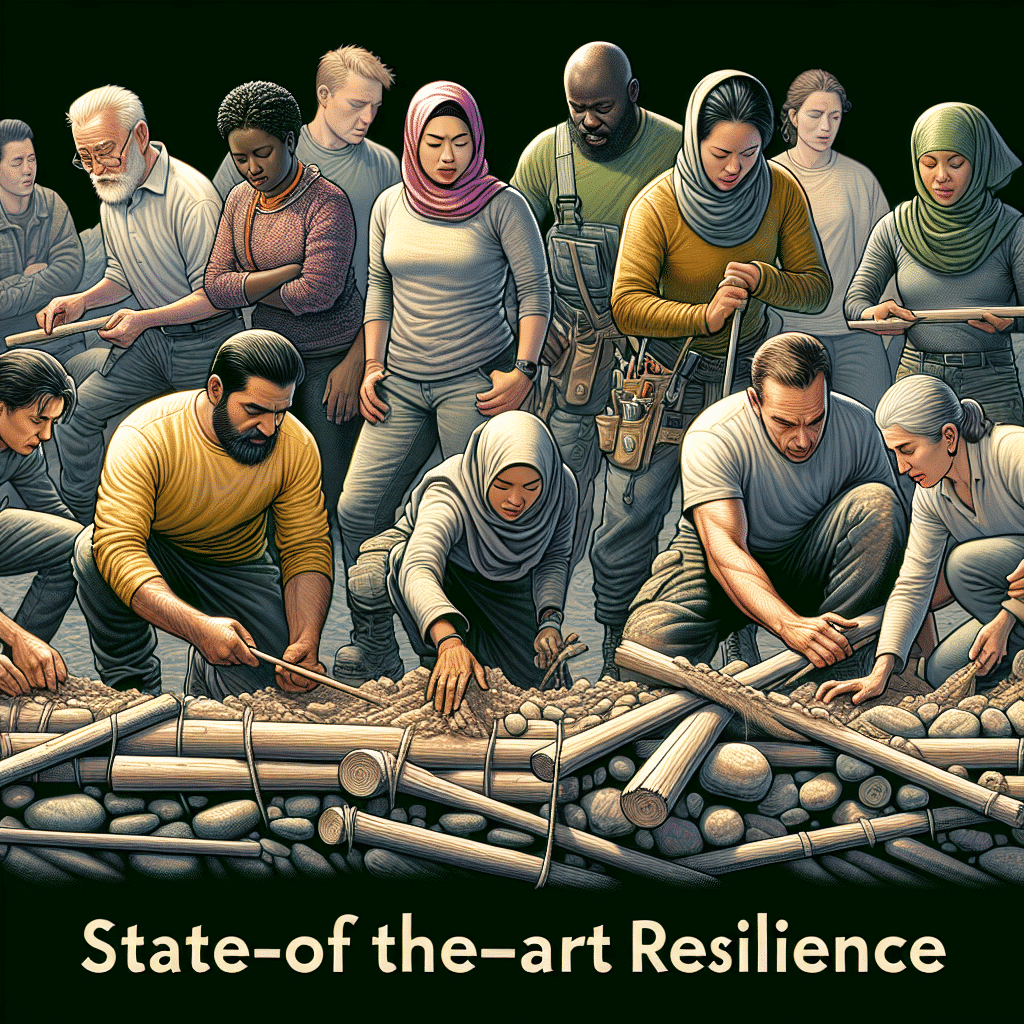
Understanding Resilience
Resilience is the ability to bounce back from challenges, adversity, and setbacks. It is a valuable skill that can help individuals navigate life’s ups and downs with more ease and grace. Understanding resilience means recognizing that it is not about avoiding difficulties, but about being able to adapt and learn from them.
Having applied resilience means putting this understanding into practice in real-life situations. It involves actively working on building resilience skills and applying them when faced with obstacles or stressors. This proactive approach can lead to better problem-solving, improved mental health, and increased overall well-being.
Applied resilience can be cultivated through various strategies and practices, including mindfulness, self-care, positive thinking, and seeking social support. By developing a resilient mindset and incorporating resilience-building activities into daily life, individuals can better cope with challenges and thrive in the face of adversity.
Importance of Applied Resilience
Resilience is a crucial skill that allows individuals to adapt and bounce back in the face of challenges, setbacks, and adversity. While some people may naturally possess resilience, it is also a quality that can be developed and strengthened through practice and conscious effort. Applied resilience, therefore, plays a vital role in one’s ability to navigate through life’s ups and downs with grace and perseverance.
Applied resilience is important for several reasons. First and foremost, it enables individuals to effectively cope with stress and overcome obstacles. By cultivating resilience, individuals can maintain a positive outlook, stay focused on their goals, and manage their emotions in a healthy manner. This allows them to navigate through difficult situations without feeling overwhelmed or defeated.
Moreover, applied resilience fosters mental toughness and emotional stability. When faced with challenges, resilient individuals are better equipped to stay calm under pressure, make sound decisions, and adapt to changing circumstances. This not only enhances their ability to persevere in the face of adversity but also enables them to thrive in the midst of uncertainty and change.
Additionally, applied resilience promotes personal growth and self-improvement. By embracing challenges and setbacks as opportunities for learning and growth, individuals can build resilience and develop new skills, insights, and perspectives. This enables them to become more resilient, adaptable, and resourceful individuals who are better equipped to navigate through life’s inevitable ups and downs.
Overall, applied resilience is essential for building a strong foundation for personal success and well-being. By developing and strengthening resilience through practice and application, individuals can enhance their ability to cope with adversity, build mental toughness, and foster personal growth. In today’s fast-paced and unpredictable world, cultivating resilience is more important than ever, as it enables individuals to thrive in the face of challenges and emerge stronger, wiser, and more resilient than before.
Applied Resilience in Practice
Building resilience is not just about understanding its concept, but also about applying it in real-life situations. Here are some tips on how to effectively practice resilience in your daily life:
1. Develop a Growth Mindset
Having a growth mindset is essential for building resilience. Instead of viewing challenges as obstacles, see them as opportunities for growth and learning. Embrace failures as a part of the learning process and focus on what you can do differently next time.
2. Cultivate Strong Support Networks
Having a strong support system can help you navigate through tough times. Surround yourself with positive and supportive individuals who can provide encouragement and guidance when needed. Reach out to friends, family, or professional networks for help.
3. Practice Self-Care
Taking care of yourself physically and mentally is crucial for building resilience. Make time for activities that bring you joy and relaxation, such as exercise, meditation, or hobbies. Prioritize self-care to maintain a positive outlook and cope with stress effectively.
4. Set Realistic Goals
Setting realistic and achievable goals can boost your confidence and resilience. Break down larger goals into smaller, manageable steps to avoid feeling overwhelmed. Celebrate your accomplishments along the way to stay motivated and focused.
5. Learn from Past Experiences
Reflect on past challenges and how you overcame them to build resilience. Identify the strategies that worked well for you in the past and apply them to current situations. Use your past experiences as a source of strength and knowledge to overcome future obstacles.
6. Seek Professional Help When Needed
Don’t hesitate to seek professional help if you feel overwhelmed or unable to cope with stress. Therapy, counseling, or support groups can provide you with the tools and resources to build resilience and navigate through difficult times effectively.

Case Studies of Applied Resilience
Case studies serve as valuable examples of how individuals and organizations have successfully applied resilience in practice to navigate challenges and achieve goals. By examining real-life scenarios where resilience was a key factor in overcoming adversity, we can gain insights and inspiration for our own resilience-building efforts.
Case Study 1: Overcoming Personal Loss
Emily, a young professional, experienced a devastating personal loss when her father passed away unexpectedly. Despite the grief and turmoil, Emily demonstrated remarkable resilience by seeking support from loved ones, engaging in therapy, and practicing self-care activities such as meditation and exercise. Through her resilience and determination, Emily was able to gradually process her grief, find new sources of strength, and eventually resume pursuing her career goals with renewed vigor.
Case Study 2: Resilience in the Workplace
Mark, a manager at a tech company, faced a major setback when a key project he was leading encountered unexpected challenges. Rather than giving in to despair or blame, Mark applied resilience by reframing the situation as a learning opportunity, collaborating with his team to find creative solutions, and maintaining open communication with stakeholders. Despite the initial setbacks, Mark’s resilience and adaptability enabled the team to successfully navigate the challenges and ultimately deliver a successful project.
Case Study 3: Building Community Resilience
In the wake of a natural disaster, a local community came together to rebuild and recover from the devastation. By fostering a sense of solidarity, mobilizing resources, and implementing sustainable recovery initiatives, the community demonstrated remarkable resilience in the face of adversity. Through collective efforts and a shared commitment to building back stronger, the community was able to not only recover but also strengthen its resilience for future challenges.
These case studies highlight the diverse ways in which resilience can be applied in various contexts, from personal struggles to workplace challenges to community crises. By learning from these examples and drawing inspiration from the resilience shown by others, we can better equip ourselves to face adversity, adapt to change, and thrive in the face of uncertainty.
Implementing Resilience Strategies in Daily Life
Resilience is a valuable skill that can be developed and applied in various aspects of daily life. By incorporating resilience strategies into your routine, you can better deal with challenges and setbacks that may come your way. Here are some practical tips for implementing resilience strategies in your daily life:
1. Practice Mindfulness
Mindfulness involves being present in the moment and aware of your thoughts and feelings. By practicing mindfulness regularly, you can reduce stress, improve self-awareness, and enhance your ability to cope with difficult situations.
2. Build Relationships
Strong social connections are essential for building resilience. Seek support from friends, family, or a support group during tough times. Having a support system can provide comfort, perspective, and encouragement during challenging moments.
3. Cultivate Optimism
Optimism involves maintaining a positive outlook, even in the face of adversity. By focusing on potential solutions and opportunities, rather than dwelling on problems, you can enhance your resilience and adaptability.
4. Develop Problem-Solving Skills
When faced with a challenge, approach it with a problem-solving mindset. Break down the problem into manageable steps, brainstorm potential solutions, and take proactive steps to address the issue. By developing effective problem-solving skills, you can navigate obstacles with confidence.
5. Take Care of Yourself
Self-care is essential for maintaining resilience. Prioritize your physical and mental well-being by getting enough sleep, eating nutritious foods, exercising regularly, and engaging in activities that bring you joy. By taking care of yourself, you can better cope with stress and bounce back from setbacks.
By incorporating these resilience strategies into your daily life, you can develop a strong foundation for navigating challenges and thriving in the face of adversity. Practice mindfulness, build relationships, cultivate optimism, develop problem-solving skills, and prioritize self-care to enhance your resilience and overall well-being.

Summary
Applied resilience is crucial in navigating the challenges and uncertainties of life. By actively incorporating resilience strategies into daily routines and mindset, individuals can better adapt, cope, and thrive in the face of adversity.
Building resilience involves developing a strong support network, fostering a positive outlook, and honing problem-solving skills. Real-life case studies serve as inspiring examples of how individuals have overcome setbacks through resilience.
Ultimately, the practice of applied resilience is a powerful tool that empowers individuals to bounce back from setbacks, grow stronger, and face future challenges with confidence and determination.






